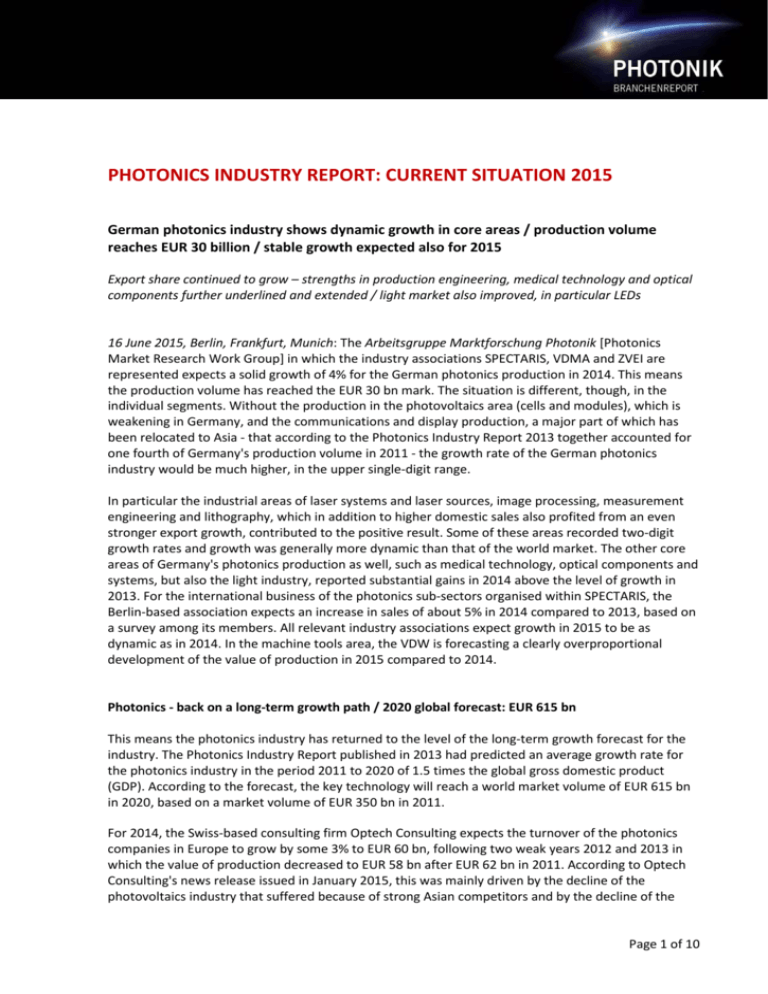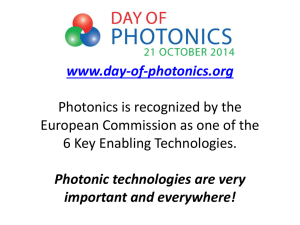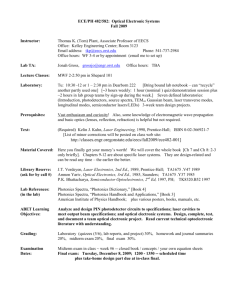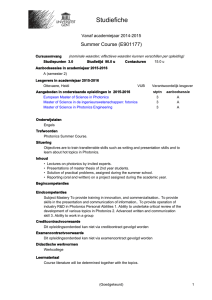photonics industry report: current situation 2015
advertisement

PHOTONICS INDUSTRY REPORT: CURRENT SITUATION 2015 German photonics industry shows dynamic growth in core areas / production volume reaches EUR 30 billion / stable growth expected also for 2015 Export share continued to grow – strengths in production engineering, medical technology and optical components further underlined and extended / light market also improved, in particular LEDs 16 June 2015, Berlin, Frankfurt, Munich: The Arbeitsgruppe Marktforschung Photonik [Photonics Market Research Work Group] in which the industry associations SPECTARIS, VDMA and ZVEI are represented expects a solid growth of 4% for the German photonics production in 2014. This means the production volume has reached the EUR 30 bn mark. The situation is different, though, in the individual segments. Without the production in the photovoltaics area (cells and modules), which is weakening in Germany, and the communications and display production, a major part of which has been relocated to Asia - that according to the Photonics Industry Report 2013 together accounted for one fourth of Germany's production volume in 2011 - the growth rate of the German photonics industry would be much higher, in the upper single-digit range. In particular the industrial areas of laser systems and laser sources, image processing, measurement engineering and lithography, which in addition to higher domestic sales also profited from an even stronger export growth, contributed to the positive result. Some of these areas recorded two-digit growth rates and growth was generally more dynamic than that of the world market. The other core areas of Germany's photonics production as well, such as medical technology, optical components and systems, but also the light industry, reported substantial gains in 2014 above the level of growth in 2013. For the international business of the photonics sub-sectors organised within SPECTARIS, the Berlin-based association expects an increase in sales of about 5% in 2014 compared to 2013, based on a survey among its members. All relevant industry associations expect growth in 2015 to be as dynamic as in 2014. In the machine tools area, the VDW is forecasting a clearly overproportional development of the value of production in 2015 compared to 2014. Photonics - back on a long-term growth path / 2020 global forecast: EUR 615 bn This means the photonics industry has returned to the level of the long-term growth forecast for the industry. The Photonics Industry Report published in 2013 had predicted an average growth rate for the photonics industry in the period 2011 to 2020 of 1.5 times the global gross domestic product (GDP). According to the forecast, the key technology will reach a world market volume of EUR 615 bn in 2020, based on a market volume of EUR 350 bn in 2011. For 2014, the Swiss-based consulting firm Optech Consulting expects the turnover of the photonics companies in Europe to grow by some 3% to EUR 60 bn, following two weak years 2012 and 2013 in which the value of production decreased to EUR 58 bn after EUR 62 bn in 2011. According to Optech Consulting's news release issued in January 2015, this was mainly driven by the decline of the photovoltaics industry that suffered because of strong Asian competitors and by the decline of the Page 1 of 10 optics-based information technology. In contrast to this, segments that traditionally were strong in Europe, i.e. laser systems, laser sources, image processing, measurement engineering, medical technology and optical components, were able to hold their ground well, says the consulting firm. German laser industry grows more dynamically than the global market in 2014 With respect to laser systems, the VDMA is expecting an increase of the production of the Germanbased manufacturers represented by the VDMA of 11% in 2014 compared to 2013 when production grew by 8% on the previous year. Consolidated on a global scale, i.e. including the sales volumes generated by foreign subsidiaries of internationally operating groups of companies, the result was a growth rate of 10%, exceeding the value of one billion euros. This means the growth rate of production in Germany is higher than the growth rate of the global market, which Optech Consulting estimates to be about 8%. The VDMA as well reports an even stronger export growth of 16%, so that the export share of laser systems from Germany currently is 78%, which is far higher than the export share of the entire manufacturing industry, which is about 48%. Based on volume, with respect to the shares in the entire export volume, the regions Western Europe, "rest of Asia" (excluding the separately determined destinations China and Japan), Central/Eastern Europe and USA contribute to this momentum in the order given. For laser sources, the 5% increase to EUR 668 m was slightly lower than that for laser systems. According to the VDMA's Arbeitsgemeinschaft Laser und Lasersysteme für die Materialbearbeitung [Working Group Lasers and Laser Systems for the Machining of Materials], the 2011 record level of EUR 697 m was not yet fully reached again in this segment, in contrast to the systems segment. Here as well, the export growth of about 15% in 2014 compared to 2013 was a mainstay of the gain. The export share rose to 61% of the value of production, with distinctive growth recorded primarily in Western Europe and Asia and the U.S. share slightly declining due to the strong basic effect from the project business in 2013. Industrial image processing - two-digit growth in 2014 Another strong growth of 16% to about EUR 1.9 bn occurred in the industrial image processing sector in 2014 compared to 2013, as reported by the relevant VDMA department. As in the other segments, the 19% increase in exports (compared to 2013) contributed substantially to the growth. The export share rose to 59%, with the U.S., China and Japan turning out to be growth markets. The European market which had been affected by the EU debt crisis of 2013 gathered pace again in 2014 and the share of exports to that market rose from 23% to 25%. All in all, industrial image processing sales grew by 10% annually on average in the period 2010 to 2016. The sales volume of industrial image processing has doubled within ten years. For the year 2015 as well, the VDMA's image processing special department is expecting the industry to continue to grow at a rate of 10%. The major growth drivers in this area are cameras which have achieved an increase in sales of 16% despite falling prices, and the system business. For years, so-called smart cameras have been in vogues that do the computing directly in the camera. And the area of application of industrial image processing systems is also widening from the former core area of inspection towards quality assurance and the optimisation of production processes. As regards the customer markets, the automotive Page 2 of 10 industry not only remains the most important sector, accounting for about 23% of all sales, but it also is an important innovation driver. 73% of all industrial image processing systems are sold to the manufacturing industry, but non-industrial customers (intelligent traffic systems, medical technology, logistics, mail sorting systems and security and supervision) are gaining importance and sales to them have grown by 19% in 2014. Lithography - photonics for semiconductor industry equipment The lithography systems reported in the photonics segment are for the most part wafer steppers for the manufacture of semiconductors. This market is dominated by a few suppliers, e.g. ASML, Nikon and Canon. The German photonics industry in this segment are suppliers of components and systems for steppers that, accordingly, mainly swim in the wake of the very successful Dutch ASML, and manufacturers of special-purpose machines. Meanwhile, EUV is no longer questioned in principle, although DUV machines are still dominant. The semiconductor industry, to which lithography systems also belong as a part of the value-added chain, has traditionally been marked by substantial sales fluctuations. Following a severe slump of almost 14% in 2013, sales of semiconductor production equipment are currently increasing strongly again, according to the current report issued by the international industry association SEMI. In 2014, worldwide sales increased by about 19% to a total of USD 37.97 bn and a dynamic 15% growth is expected also in 2015. VDMA's productronic special department is expecting the situation to be similarly positive for the European equipment manufacturers. In 2014, they achieved a plus of about 10% to 12% and will be able to grow by another 3% or so in 2015 as well. Optical systems in medical technology - solid growth According to SPECTARIS, the German medical technology industry increased its sales by 2.3% in 2014. A slump in the Russian business and a rather weak trend in the U.S. and China were the reasons for the comparably low result. In recent years, the annual growth rates were between 5% and 6% on average. However, SPECTARIS is expecting a clearly higher plus in the area of optical medical technology in 2014 compared to the medical technology sector altogether. Studies are forecasting annual increases in the order of 6% to 9% on average for endoscopy, in-vitro diagnostics (in particular the point-of-care area) and medical lasers and laser sources. In addition to new examination or treatment options and other benefits for the patients, optical methods often result in an increase in efficiency in the highly cost-driven health care system. These aspects, among others, and the higher demand from the emerging markets contribute to the high growth rates. In addition to the health care sector, primarily the food industry is an important driver of future growth in the biophotonics area. As AT Kearney has forecast in a supplementary study "Biophotonics" for the Photonics Industry Report 2013, the area of optical food diagnostics will grow by 14.5% by 2020. Page 3 of 10 According to SPECTARIS, analytical, bio and laboratory technologies, where many methods are based on optical systems such as spectroscopy, microscopy or fluorescence scanners, recorded a gain of about 6.2% in 2014. The association is expecting a similar result for 2015. In the electromedicine sector, the ZVEI is assuming a growth of about 5% in 2014 for the world market, after a slight decrease of 0.2% to EUR 87 bn in 2013. For 2015, the Frankfurt-based association is expecting the growth rate to be similar to that in 2014. The German light market has arrived at the LED era The Light trade association of the ZVEI is reporting the entire light industry in Germany to have grown by 3.2%, which is about double the rate of growth of the German GDP. The light world market which slightly declined in 2013 and achieved a sales level of EUR 92.9 bn grew on approximately the same scale of between 3% and 4%. For 2015, the ZVEI is expecting a solid growth for both Germany and the world at a level comparable to that of 2014. As regards innovative products, LEDs continued to establish themselves and meanwhile have a market share of 60% (sales) in the outdoor lighting area and 45% in the interior lighting area. With that, LED technology has gained acceptance even faster than forecast by McKinsey in the study published in 2012 that had predicted LEDs to reach a 58% share in sales only in 2016. The ZVEI estimates that not least public incentive programmes and funding initiatives in the area of town lighting have contributed to this. In 2014, LEDs grew by about 8.2% in Germany. The association believes that a stronger focus on light efficiency and light quality instead of just on service life and lumen per watt might contribute to further boosting growth also in the broad consumer sector. Apart from that, the trade association sees intelligent light control, i.e. the integration of intelligence into the lamp, as a future key growth driver. As has been the case already when the LED was introduced, this will have a substantial influence on the business models and the depth of integration of the manufacturers and dealers. Photovoltaics equipment suppliers: German mechanical engineering and components well maintained The manufacturers of components, machinery and systems for photovoltaics organised within the VDMA, i.e. the suppliers of equipment to the photovoltaics industry, recorded a growth rate of nearly 6%, primarily in the first six months of 2014. The segment with the highest sales in 2014 was production equipment for the cell (45%), followed by production solutions for thin-film photovoltaics (25%). Equipment for the crystalline backend, i.e. module production, accounted for 12% and systems for polysilicon, ingot and wafer production for 18% of the sales. Despite the slump suffered by the manufacturers of cells and modules in Germany in recent years due to cheap Asian suppliers, the German photovoltaics equipment suppliers market was able to hold its Page 4 of 10 ground well and has a share of more than 50% in the world market. The export ratio which always has been high continued to rise and now is 89%, with China and Taiwan remaining the biggest sales markets. Due to the trade disputes in the second half of 2014, new sales market should arise in the future or their shares should shift. Therefore, the association is expecting higher new investments in the countries of the SEA group, the focus being on Malaysia, Singapore and Thailand. Positive signals also come from the U.S. and the emerging markets in Latin America, South Africa and the MENA region. For 2015 as well, the VDMA's Arbeitsgemeinschaft Photovoltaik-Produktionsmittel [Working Group Photovoltaics Production Means] is expecting a solid growth in the order of 8%, based on a survey among the member companies. Graph 1: Photonics Industry Report 2015 - AG Market Research Photonics Page 5 of 10 ANNEX 1 About photonics: Photonics is the technological mastery of light in any form. Photonics focuses on the generation, control, measurement and, above all, use of light in almost all socially and economically important areas. The term "photonics" refers to the photon, the light particle, in the same way as the term "electronics" refers to the electron. Light has a number of extraordinary properties: • Focusability: To one millionth of a millimetre (nanometre) • Speed of light: The highest speed that can be achieved in the universe • Shortest pulses: Up to one billionth of one billionth of a second (attosecond) • Highest powers: Up to billions of megawatts (petawatt) • Undisturbed superimposition: Up to millions of megabits per second (terabit per second) The key technology of photonics makes these properties useful. Starting from a common technological basis, it combines areas so diverse as production engineering, power and lighting engineering, medical technology, environmental technology, plasma technology and information and communication technology. (Source: BMBF, Photonics Research Germany - http://www.photonikforschung.de/was-istphotonik/) About the Arbeitskreis Marktforschung Photonik and the Photonics Industry Report 2013 In 2011, the industry associations SPECTARIS, VDMA and ZVEI, supported by the Bundesministerium für Bildung und Forschung (BMBF) [Federal Ministry of Education and Research], allied to set up a work group called Arbeitskreis Marktforschung Photonik [Photonics Market Research Work Group] and together prepared the first Photonics Industry Report 2013. The report predicts a long-term growth of the photonics industry until the year 2020 with an average of 1.5 times the growth rate of the global gross domestic product. Based on a market volume of EUR 350 bn in 2011, the world market for this key technology will grow to EUR 615 bn by 2020. Counted over all segments, the German photonics industry's share is 8%, but in the core areas production engineering, i.e. laser systems, laser sources and lithography systems, and image processing and measurement technology, medical technology and optical components and systems, its share is far greater. Page 6 of 10 Important links: BMBF, Photonics Research Germany: http://www.photonikforschung.de/index.php Photonics21: http://www.photonics21.org/ SPECTARIS, Trade Association Photonics: http://www.spectaris.de/photonik.html SPECTARIS, Trade Association Medical Technology: http://www.spectaris.de/medizintechnik.html SPECTARIS, Business Economics : http://www.spectaris.de/verband/betriebswirtschaft.html VDMA Photonics Forum: http://photonik.vdma.org/ VDMA Lasers and Laser Systems for the Machining of Materials: http://laser.vdma.org/ VDMA, Electronics, Micro and Nano Technologies, Special Department Productronic: http://prod.vdma.org/ VDMA Industrial Image Processing: http://ibv.vdma.org/ VDMA Photovoltaics Production Means: http://pv.vdma.org/ ZVEI, Trade Association Light: http://www.zvei.org/Verband/Fachverbaende/Licht/Seiten/default.aspx ZVEI, Trade Association Electromedicine Technology: http://www.zvei.org/Verband/Fachverbaende/ElektromedizinischeTechnik/Seiten/default.aspx ZVEI, Economy & Analyses: http://www.zvei.org/MaerkteRecht/KonjunkturundAnalysen/Seiten/default.aspx Contact: Mike Bähren SPECTARIS Economics and Statistics +49 30 41 40 21-20 baehren@spectaris.de Annika Löffler VDMA Photonics Forum +49 69 756081-22 a.loeffler@vdw.de Gerhard Hein VDMA Laser & Laser Systems for Material Processing +49 69 756081-43 g.hein@vdw.de Ursula Tober VDI Technologiezentrum GmbH Senior Economist & Technology Consultant +49 211 62 14 668 tober@vdi.de For Munich Trade Fair: Laser World of Photonics2015 Ivanka Stefanova-Achter LASER World of PHOTONICS Messe München GmbH Press officer + Tel. +49 89 949-21488 Ivanka.Stefanova-Achter@messe-muenchen.de Page 7 of 10 ANNEX 2 Page 8 of 10 Page 9 of 10 Page 10 of 10



